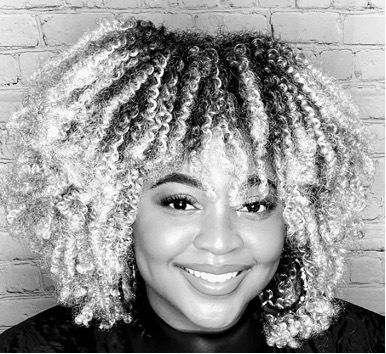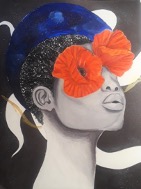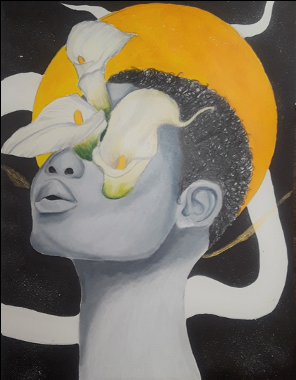February 11, 2021
Tell us about yourself
 My name is Mariah Gray, and I am a first-year graduate student at the George Washington University enrolled within the master’s Art Therapy Program. I earned my bachelor’s degree at Regent University, gaining knowledge and experience in implementing an integrative approach to psychology through the lens of Christianity. During this time, by having art as my secondary focus of study, I was able to engage in a multitude of classes including figurative drawing, painting, animation, and advanced art. With my love for art and deep interest in psychology, I was led to pursue a career within the art therapy field.
My name is Mariah Gray, and I am a first-year graduate student at the George Washington University enrolled within the master’s Art Therapy Program. I earned my bachelor’s degree at Regent University, gaining knowledge and experience in implementing an integrative approach to psychology through the lens of Christianity. During this time, by having art as my secondary focus of study, I was able to engage in a multitude of classes including figurative drawing, painting, animation, and advanced art. With my love for art and deep interest in psychology, I was led to pursue a career within the art therapy field.
Within my first semester of graduate school, I was elected as a member of the George Washington Art Therapy Student Association (GWATSA) on the Multicultural Committee. Striving to create imperative, brave spaces. the committee attempts to shine a light on areas that are often overlooked and undervalued. Being a witness to how essential it is to have such spaces where these difficult conversations can be held has been a strong motivation of my involvement within my school’s committee and potentially AATA. My desire as a student, and as a future art therapist, is to continue to hold these spaces that encourage conversations; to prompt us as individuals to look within ourselves to gain intrinsic understanding while being able to see each other more fully.
As we honor Black history, we acknowledge the importance of amplifying and supporting Black art therapists and students and the invaluable contributions they have and continue to make to our field. How do you celebrate your racial/ethnic/cultural identities in your work and studies? In what ways must you protect your identity?
I choose to celebrate my racial, cultural identity in a multitude of ways from the intentionality behind my hair styles to the art that I produce. The beauty that is exemplified through the hairstyles I choose to wear highlights a rooted history within the Black culture. Whether I wear my hair in its curly state, braids, or head wraps, each style is a powerful, expressionistic representation of my cultural identity. I have discovered a voice through not only my hair statements but my art as well. Through art, I have developed a process that is able to synthesize both creativity and my cultural identity in a way that portrays my individual style.
Preserving my identity heavily relies on community and safe spaces. Being able to share my experiences, to exchange knowledge, and to gain insight with other individuals who are affiliated with my culture provides a sense of belonging and comfort. By spreading awareness of my cultural identity to others as well provides an opportunity to discredit misconceptions that have been adapted as “cultural norms” in society. Lastly, I personally strive to continue to educate myself on the vast history of my culture in order to fully be aware of my identity.
In what ways does attending a predominantly white institution (PWI) affect your art therapy training? Are there systems in place to address diversity and make transformative changes?
As a black woman pursuing a career in art therapy, attending a predominantly white institution certainly has an impact on my educational and training development. In the classroom, I feel obligated to perform as a student while also presenting myself in the role of a teacher. It is sometimes burdensome being the only person in the class to have a different perspective than everyone else. However, I view these instances as an opportunity to provide insight to my counterparts who otherwise may not have had that same environment to indulge in such conversations.
As a first-year student, I am aware of the structures that have been formed as a direct result of both professors and second year students coming together in deciding changes that needed to be executed. Certain classroom spaces that are held evoke conversations regarding topics such as racial injustice, cultural humility, and power structures within the therapeutic relationship as well. On the George Washington Art Therapy Student Association’s (GWATSA) Multicultural Committee, we strive to also present other avenues that can lead to discussions within our cohort through recognizing and acknowledging commemorative months such as Black History Month. By addressing diversity, the hope is to create spaces where all members are able to engage in dialogue that can lead to an inclusive, transformative process.
Countless videos capturing acts of hate, racism, and police brutality continue to spark national dialogue. How have race-related issues, social justice, and racism informed or impacted your studies as an art therapy student?
The impact of constant reminders of police brutality and systemic racism has allowed me to discover an area within my studies that needs further exploration. Understanding the effects of a multigenerational trauma on a group of people has influenced my pursuit in discovering opportunities for art therapy to serve as a vessel to possibly bring healing. Through further exploration of the idea of addressing generationally embedded trauma, I hope to become informed on the insight art therapy is able to provide.
How do you use art to honor your culture or heritage?
In every opportunity I receive, I attempt to exemplify my culture in the way I believe it should be represented. I depict all of the figures within my art as persons emulating divine royalty along with my integration of surrealism. Through this, I believe that my artwork is able to shine a light on the beauty and layered diversity of the Black community.


“A Communal Encounter” by Mariah R. Gray. Acrylic paint, markers, and colored pencils. February 2021.
A communal encounter, meaning an experience shared within the same space as others, was my inspiration for this art piece. I wanted my artwork to exemplify the terminology, “I see you” and represent every aspect of its meaning. Although not every student will have the exact same background, being in the same space together allows for a bond and connection to form that is unlike any other. I am truly grateful for the bonds I have established with those in my program and I look forward to furthering this experience.
